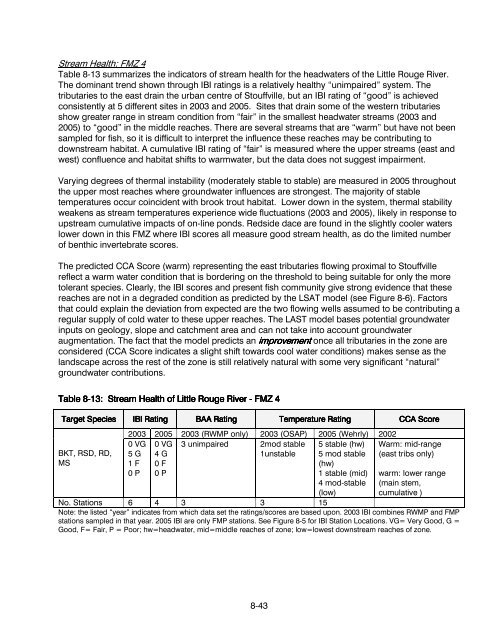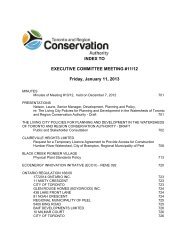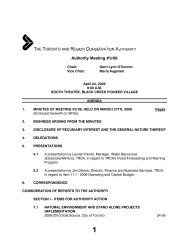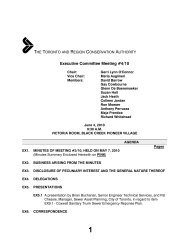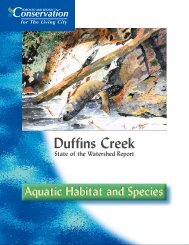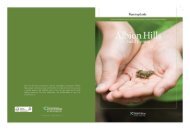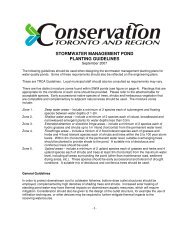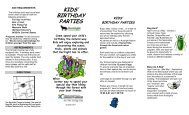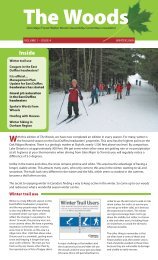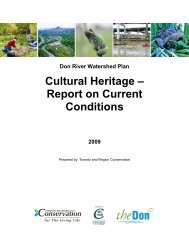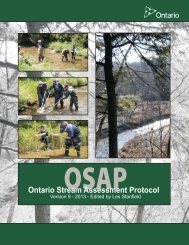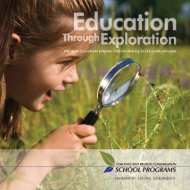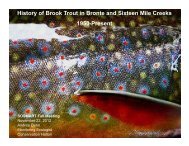Aquatic System - Toronto and Region Conservation Authority
Aquatic System - Toronto and Region Conservation Authority
Aquatic System - Toronto and Region Conservation Authority
Create successful ePaper yourself
Turn your PDF publications into a flip-book with our unique Google optimized e-Paper software.
Stream Health: FMZ 4Table 8-13 summarizes the indicators of stream health for the headwaters of the Little Rouge River.The dominant trend shown through IBI ratings is a relatively healthy “unimpaired” system. Thetributaries to the east drain the urban centre of Stouffville, but an IBI rating of “good” is achievedconsistently at 5 different sites in 2003 <strong>and</strong> 2005. Sites that drain some of the western tributariesshow greater range in stream condition from “fair” in the smallest headwater streams (2003 <strong>and</strong>2005) to “good” in the middle reaches. There are several streams that are “warm” but have not beensampled for fish, so it is difficult to interpret the influence these reaches may be contributing todownstream habitat. A cumulative IBI rating of “fair” is measured where the upper streams (east <strong>and</strong>west) confluence <strong>and</strong> habitat shifts to warmwater, but the data does not suggest impairment.Varying degrees of thermal instability (moderately stable to stable) are measured in 2005 throughoutthe upper most reaches where groundwater influences are strongest. The majority of stabletemperatures occur coincident with brook trout habitat. Lower down in the system, thermal stabilityweakens as stream temperatures experience wide fluctuations (2003 <strong>and</strong> 2005), likely in response toupstream cumulative impacts of on-line ponds. Redside dace are found in the slightly cooler waterslower down in this FMZ where IBI scores all measure good stream health, as do the limited numberof benthic invertebrate scores.The predicted CCA Score (warm) representing the east tributaries flowing proximal to Stouffvillereflect a warm water condition that is bordering on the threshold to being suitable for only the moretolerant species. Clearly, the IBI scores <strong>and</strong> present fish community give strong evidence that thesereaches are not in a degraded condition as predicted by the LSAT model (see Figure 8-6). Factorsthat could explain the deviation from expected are the two flowing wells assumed to be contributing aregular supply of cold water to these upper reaches. The LAST model bases potential groundwaterinputs on geology, slope <strong>and</strong> catchment area <strong>and</strong> can not take into account groundwateraugmentation. The fact that the model predicts an improvement once all tributaries in the zone areconsidered (CCA Score indicates a slight shift towards cool water conditions) makes sense as thel<strong>and</strong>scape across the rest of the zone is still relatively natural with some very significant “natural”groundwater contributions.Table 8-1313: Stream Health of Little Rouge River - FMZ 4Target SpeciesBKT, RSD, RD,MSIBI RatingBAA RatingTemperature Rating2003 2005 2003 (RWMP only) 2003 (OSAP) 2005 (Wehrly) 20020 VG 0 VG 3 unimpaired 2mod stable 5 stable (hw)5 G 4 G1unstable 5 mod stable1 F 0 F(hw)0 P 0 P1 stable (mid)4 mod-stableCCA CA ScoreWarm: mid-range(east tribs only)warm: lower range(main stem,cumulative )(low)No. Stations 6 4 3 3 15Note: the listed “year” indicates from which data set the ratings/scores are based upon. 2003 IBI combines RWMP <strong>and</strong> FMPstations sampled in that year. 2005 IBI are only FMP stations. See Figure 8-5 for IBI Station Locations. VG= Very Good, G =Good, F= Fair, P = Poor; hw=headwater, mid=middle reaches of zone; low=lowest downstream reaches of zone.8-43


